Tunnels of Cu Chi

Peregrina's Journey
Peter and Margie Benziger
Sun 7 Apr 2013 03:20
Recently, we left Peregrina for a 15 day backpacking trip to
Vietnam. We traveled from Ho Chi Min City (formerly known as Saigon) to Hoi An,
Danang, Khe Sahn, Hue and, finally, Hanoi.
Along the way, we met some lovely people, saw some amazing scenery and
witnessed a vibrant economy that, while still officially Communist, has all the
trappings of a capitalist society in the 21st Century.
But, most of all, we learned a lot about the Vietnam War
from the Vietnamese perspective.
Over the course of two weeks in Vietnam, it became clear why
America was unable to win that war which dominated the world’s attention (and
tore America apart) during our college years.
As we visited several of the
major sites of military action that we remembered from the Nightly News back in
the 60’s & 70’s, we reviewed the facts without the “…America is Winning the
War against Communism” tactical spin.
To supplement our knowledge of what happened here, we relied
heavily on an amazing book titled The Tunnels of Cu Chi by Tom Mangold
and John Penycate (Berkley Books Publishing Group, New York) which had been
given to us by some Australian cruising friends before our departure. In an ironic turn of events, Tom Mangold is a
British journalist whose illustrious career includes two decades as a war
correspondent and then ten years as an investigative reporter for the BBC TV
news. He continues to produce TV
specials for BBC but now enjoys the less stressful task of travel writing for a
number of UK publications. He became one
of Margie’s “go to” journalists from “across the pond” when she was working in
Travel PR at Cheryl Andrews Marketing. We had a great dinner with Tom and his wife in
Coconut Grove just before we left on our sailing adventure 3 ½ years ago and
now, we run into him again via this book.
It truly is a VERY small world!
We can recommend The Tunnels of Cu Chi highly and
thank Tom and John for all their research which helped us out immensely in
writing this article.
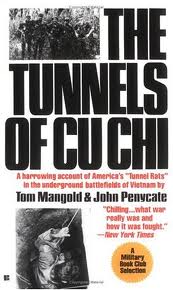
So…let’s give you a little background information since many
of our readers are too young to remember the highly charged Vietman War era…
Vietnam is a long country running north to south with the
South China Sea and Gulf of Tonkin on its’ eastern shore, Cambodia and Laos on the west and
China bordering on the north.
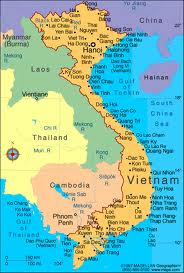
The Cu Chi district lies northwest of Saigon in what was
then called South Vietnam. The border
between North and South Vietnam was the 17th parallel (Latitude)
near Danang in what was the infamous DMZ, or DeMilitarized Zone.

The Cu Chi district became the most bombed, shelled, gassed,
defoliated and generally devastated area in the history of warfare. More bombs
were used in the Vietnam War than throughout all the military theaters of WWII.
By 1967, the 25th Infantry division was raining 200,000 shells a
month into the Cu Chi district, averaging 6,500 daily. In spite of this, Cu Chi
was an area that remained unpacified throughout the war and was the center for
Viet Cong activity near Saigon.
It is estimated that there were more than 200 miles of
tunnels in South Vietnam. In the Cu Chi district alone, there were hundreds of
tunnels. Many were linked together.
No single military engineer designed this vast labyrinth.
The tunnels evolved as the natural response from a poorly equipped and mainly
local guerilla army to mid-twentieth-century technological warfare. Aircraft, bombs, artillery and chemicals
obliged the Viet Cong to live and fight underground.
A typical tunnel
complex would contain multiple concealed trap door entrances. In the picture
below you will see that the entrances were very small. Peter had to take off his belt, wallet, and
empty his pockets and then enter with his hands held over my head. I almost got stuck!
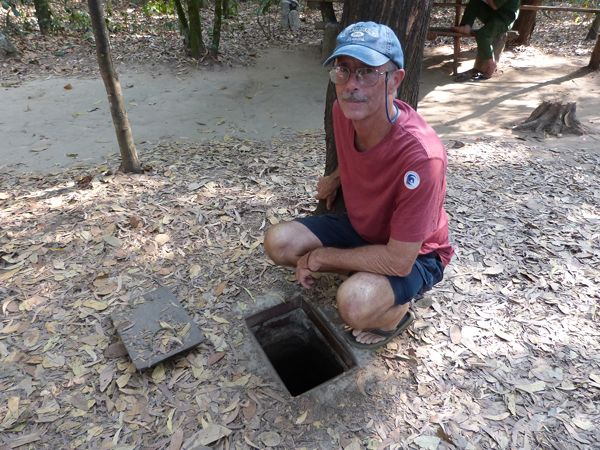
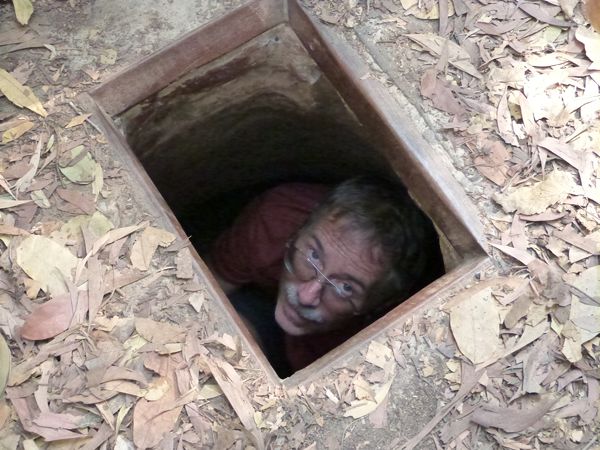
After squeezing through the entrance, Peter crawled down
three levels and then surfaced a couple
hundred yards from where he entered, Margie had a different experience.
Here is Margie going down a tunnel entrance enlarged for visitors.
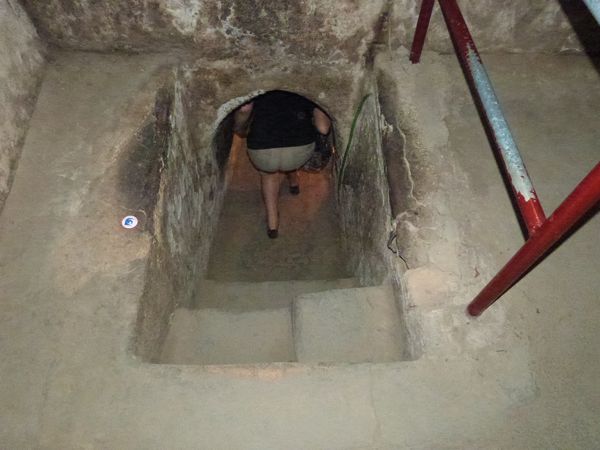
Here is Margie coming right back up the entrance saying “No
Way!).
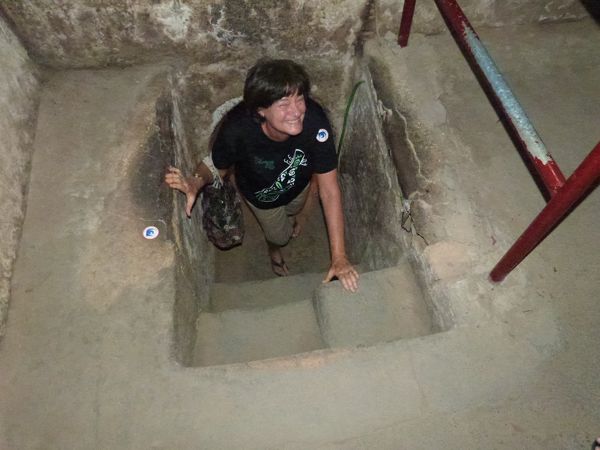
Inside some of the more elaborate tunnels one might find a
conference chamber with a kitchen, storage cache for weapons/ammo/rice, water
well and first aid station with a operating room.
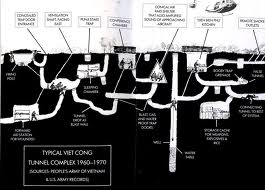
But, the majority of the tunnels were
claustrophobic, dark, dank, rat and bug-infested burrows that were no wider
than 47 inches and as narrow as 32 inches; no higher than 48 inches and as
low as 32 inches..
Life in the tunnels was hard. Captain Linh, commander of the
7th VC Battalion in Cu Chi, spent five years living underground. He
said that the wounded in his underground first aid stations “used to scream for
one look at light and one breath of air, not fresh air, just air.”
One of the initial strategies of the U.S. was to construct a
series of fortified bases outside Saigon.
The site of Cu Chi was studied from the comfort of a strategic war room
in Hawaii. General Weyland said, “We
picked this area because of the topography. It is one place, 12 meters above
the water table, where we can put trucks and tanks without having them sink
during the monsoon season. It has good drainage, access to a river and water
supply. It is ideal!”
Unfortunately, it was for those very same reasons that the
Vietnamese had been digging tunnels in Cu Chi as far back as the 1940’s and 50’s
when they were fighting the French!
On Christmas Day, 1966 Bob Hope came to the Cu Chi military
base to do a Christmas show. One of his lines was “When I landed I got a
nineteen gun salute. One of them was ours!
We’re so close to the fighting we had to give the Viet Cong half the
tickets!
Bob Hope did not appreciate the true import of his words.
After the war, it became known that while Bob Hope was performing his Christmas
show above ground, an entertainer named Pham Sang was boosting Viet Cong morale
in the tunnel below ground with his own comedy show.
It was also discovered later that one of the Vietnamese
tunnels had a secret entrance right into the U.S. supply depot on the base! The
Viet Cong would actually enter the U.S. supply depot to do midnight
shop-lifting when their supplies ran low!
General William Westmoreland, who commanded the American
forces in Vietnam from 1964-1968, said in his memoirs: “No one has ever
demonstrated more ability to hide his installations than the Viet Cong: they were human moles.”
And, it wasn’t just people hiding in these tunnels! In 1966, the Viet Cong stole a M-48 tank.
Three years later, it was found in a tunnel in Cu Chi! It was buried six feet underground and several
connecting tunnels had been dug to it. The tank was used as a VC command center;
the batteries, lights and the radio were still working.
In another tunnel, they found a 1500 pound printing press in
perfect working order; rows and rows of type, thirty seven trays together,
stacked against the walls of this huge six foot high, thirty by forty foot
chamber. A table with bottles of ink, dyes in five gallon containers and stacks
of pamphlets and papers –two tons in all.
A clever and finely engineered trapdoor system was devised
to create entrances and exits to secret passages and from one tunnel to
another. It was crucial to the plan that, even when the first tunnel level was
discovered, the secret trapdoor that led down to the next level would remain hidden
from the enemy.
The Tunnels of Cu
Chi tells the stories of several American “tunnel rats” whose job it was to
explore the tunnels. It was not a job that anyone reading this story would
want. These “tunnel rats” went down in
the tunnels with just a knife, flashlight and pistol. Many never came back.
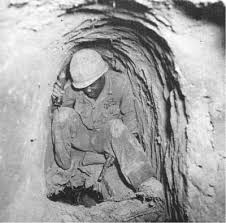
The
slogan of these tunnel fighters was “Not Worth a Rat's Ass.” In 1962 the Limited Warfare Laboratory
(LWL) in Maryland instigated a crash
program to develop new technological weapons for tunnel warfare. These included
their official “Tunnel Exploration Kit” with a new headlamp, hands free bone
conductor microphone, “silenced pistols, bullets that split into four segments
etc. Much of the kit was too bulky to even fit into the tunnels. The Tunnel Exploration
Kits were tried by the Tunnel Rats and “
gratefully” returned to the LWL … never to be seen again.
Other tactics included sending smoke, rolling grenades, tear
gas, acetylene fire, trained dogs, etc.
At the end of the war Lieutenant Colonel James Bushong, of
the 25th infantry division admitted that they never discovered any
effective way to destroy the tunnels or even deny their use to the communists.
He still does not know how he would do the job today.
Some of the Vietnamese fighters lived and fought in the Cu
Chi tunnels for up to 10 years. Only the certainty that victory was inevitable
protected the mind and body from the true horrors of tunnel life. When victory
would come was academic – perhaps in five more years, perhaps in ten. America
was a formidable fighting force; one would have to be patient.
Mangold and Penycate write, “To Asians, steeped in Confucian
concepts, time is an endless river flowing from an infinitely regenerative
source. Time to Westerners is precious (we are always in a hurry) while to the
Oriental, time is something that can be spent with generosity. Even Western
calendars are different – they have starting and stopping points. Each page has
a beginning and an end. But the Oriental calendar is in the form of a wheel, a
symbol with neither has a beginning nor an end --- a continuum. Quick victory
is a Western concept.”
Years before, Ho Ch Minh was fighting the French in Vietnam and he
said: “You can kill ten of my men for every one I kill of yours and, even at
those odds, you will lose and I will win.”
This was the basis for the war strategy against America… all the Vietnamese
had to do was not to lose. They could
use the tunnels as sanctuary, emerging when it was to their advantage and
retreating when necessary.
Time was on their side since, by simply not losing, they
would eventually win.